Comprehensive Report on Equality and Diversity and Inclusive Practice
VerifiedAdded on 2023/01/19
|26
|8189
|50
Report
AI Summary
This report provides a comprehensive overview of equality, diversity, and inclusive practices, focusing on their significance in educational and organizational settings. It defines key terms, identifies categories related to equality and diversity, and explores the importance of promoting these concepts. The report examines factors affecting learning, including abilities and barriers to equality, and suggests strategies for removing these obstacles. It analyzes relevant policy and regulatory frameworks, the influence of organizational policies, and the role of working with other agencies to promote diversity. Additionally, the report defines inclusive environments, explores roles and responsibilities in promoting inclusion, and outlines ways to promote inclusion and value individual learners. It also addresses the relationship between professional roles, referral points, and strategies to promote diversity, along with methods to promote equality and diversity through lesson plans. The report concludes by examining organizational culture and the impact of individual behaviors, as well as reviewing the effectiveness of inclusive practices and the promotion of equality and diversity.
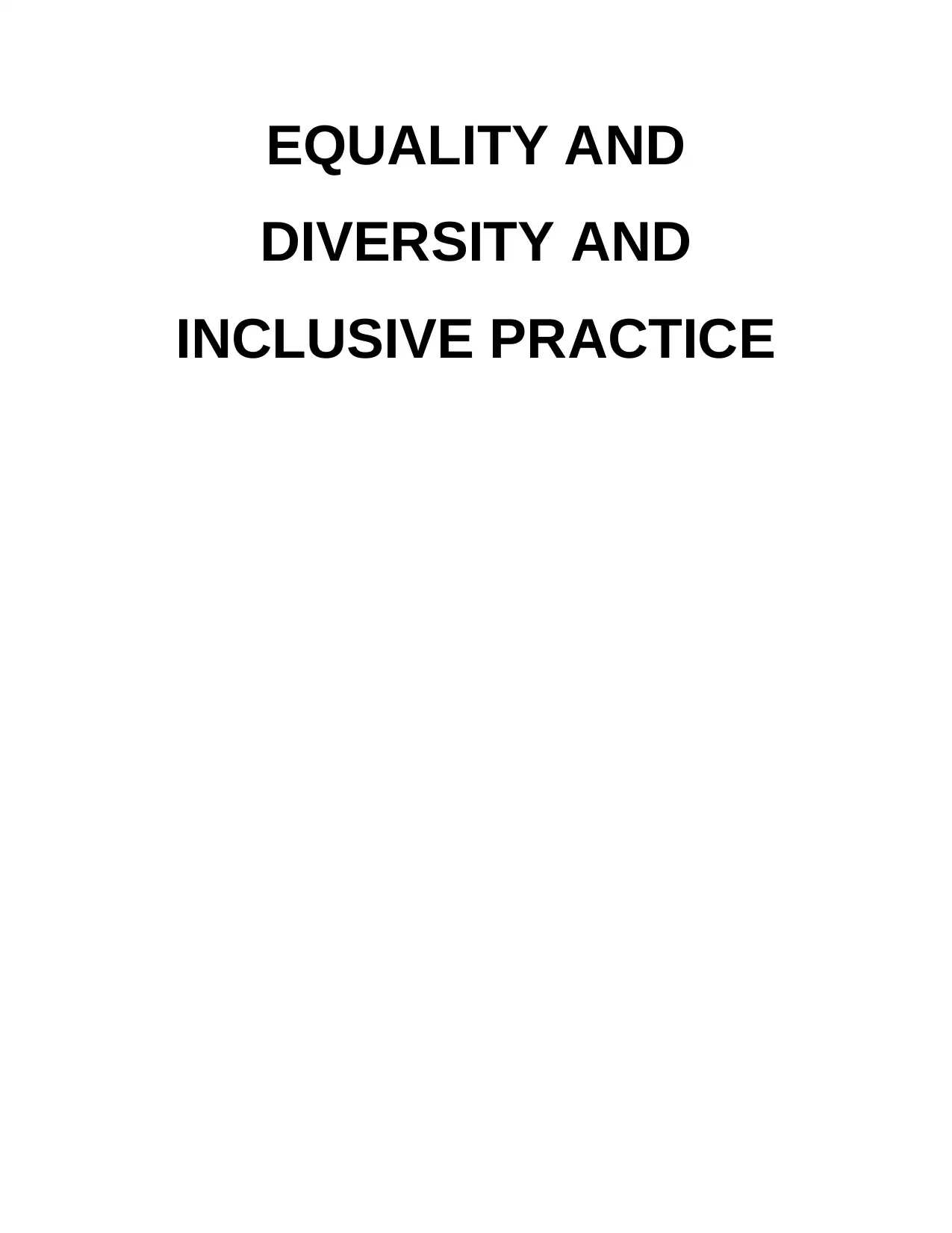
EQUALITY AND
DIVERSITY AND
INCLUSIVE PRACTICE
DIVERSITY AND
INCLUSIVE PRACTICE
Paraphrase This Document
Need a fresh take? Get an instant paraphrase of this document with our AI Paraphraser
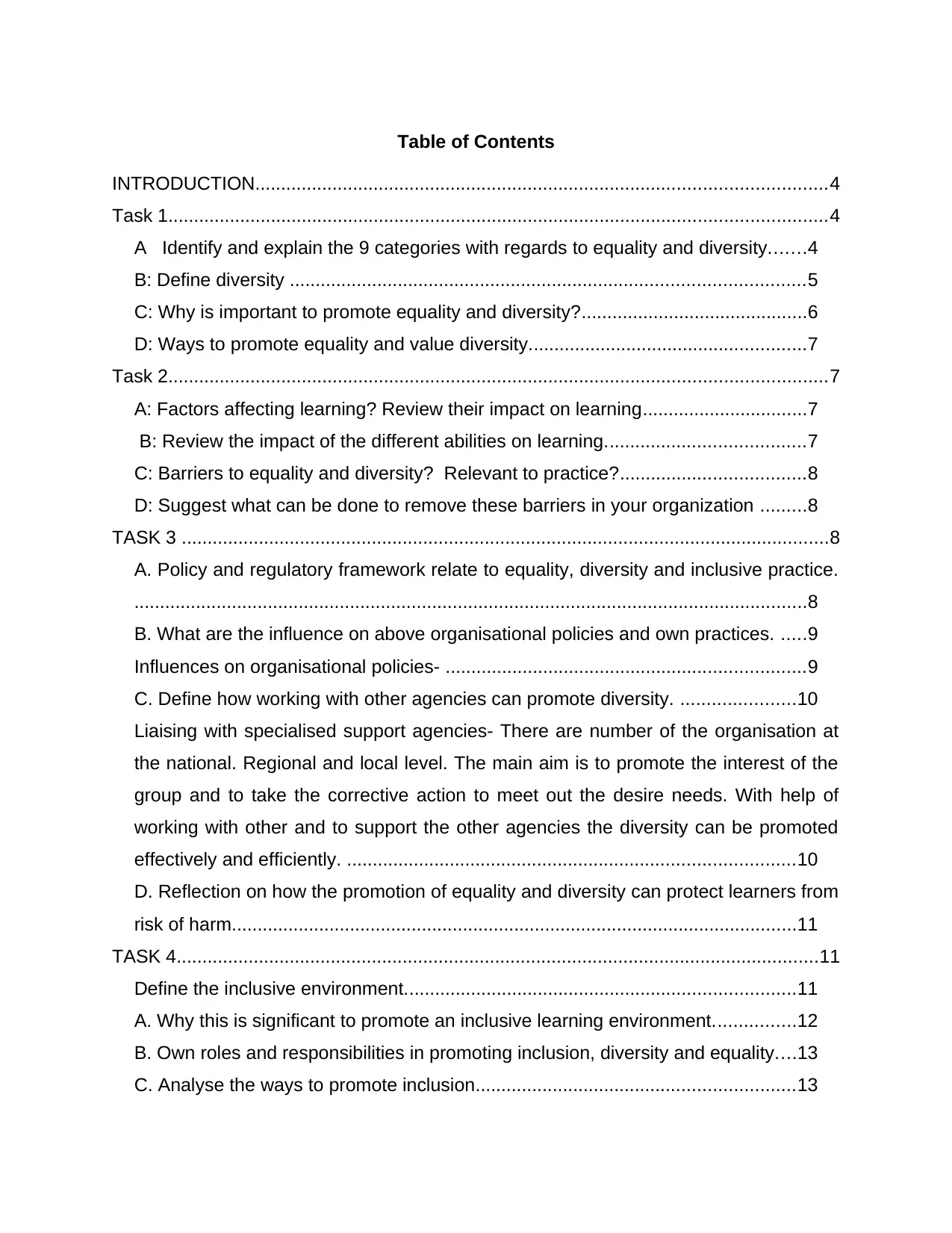
Table of Contents
INTRODUCTION...............................................................................................................4
Task 1................................................................................................................................4
A Identify and explain the 9 categories with regards to equality and diversity.......4
B: Define diversity ....................................................................................................5
C: Why is important to promote equality and diversity?............................................6
D: Ways to promote equality and value diversity......................................................7
Task 2................................................................................................................................7
A: Factors affecting learning? Review their impact on learning................................7
B: Review the impact of the different abilities on learning.......................................7
C: Barriers to equality and diversity? Relevant to practice?....................................8
D: Suggest what can be done to remove these barriers in your organization .........8
TASK 3 ..............................................................................................................................8
A. Policy and regulatory framework relate to equality, diversity and inclusive practice.
...................................................................................................................................8
B. What are the influence on above organisational policies and own practices. .....9
Influences on organisational policies- ......................................................................9
C. Define how working with other agencies can promote diversity. ......................10
Liaising with specialised support agencies- There are number of the organisation at
the national. Regional and local level. The main aim is to promote the interest of the
group and to take the corrective action to meet out the desire needs. With help of
working with other and to support the other agencies the diversity can be promoted
effectively and efficiently. .......................................................................................10
D. Reflection on how the promotion of equality and diversity can protect learners from
risk of harm..............................................................................................................11
TASK 4.............................................................................................................................11
Define the inclusive environment............................................................................11
A. Why this is significant to promote an inclusive learning environment................12
B. Own roles and responsibilities in promoting inclusion, diversity and equality....13
C. Analyse the ways to promote inclusion..............................................................13
INTRODUCTION...............................................................................................................4
Task 1................................................................................................................................4
A Identify and explain the 9 categories with regards to equality and diversity.......4
B: Define diversity ....................................................................................................5
C: Why is important to promote equality and diversity?............................................6
D: Ways to promote equality and value diversity......................................................7
Task 2................................................................................................................................7
A: Factors affecting learning? Review their impact on learning................................7
B: Review the impact of the different abilities on learning.......................................7
C: Barriers to equality and diversity? Relevant to practice?....................................8
D: Suggest what can be done to remove these barriers in your organization .........8
TASK 3 ..............................................................................................................................8
A. Policy and regulatory framework relate to equality, diversity and inclusive practice.
...................................................................................................................................8
B. What are the influence on above organisational policies and own practices. .....9
Influences on organisational policies- ......................................................................9
C. Define how working with other agencies can promote diversity. ......................10
Liaising with specialised support agencies- There are number of the organisation at
the national. Regional and local level. The main aim is to promote the interest of the
group and to take the corrective action to meet out the desire needs. With help of
working with other and to support the other agencies the diversity can be promoted
effectively and efficiently. .......................................................................................10
D. Reflection on how the promotion of equality and diversity can protect learners from
risk of harm..............................................................................................................11
TASK 4.............................................................................................................................11
Define the inclusive environment............................................................................11
A. Why this is significant to promote an inclusive learning environment................12
B. Own roles and responsibilities in promoting inclusion, diversity and equality....13
C. Analyse the ways to promote inclusion..............................................................13
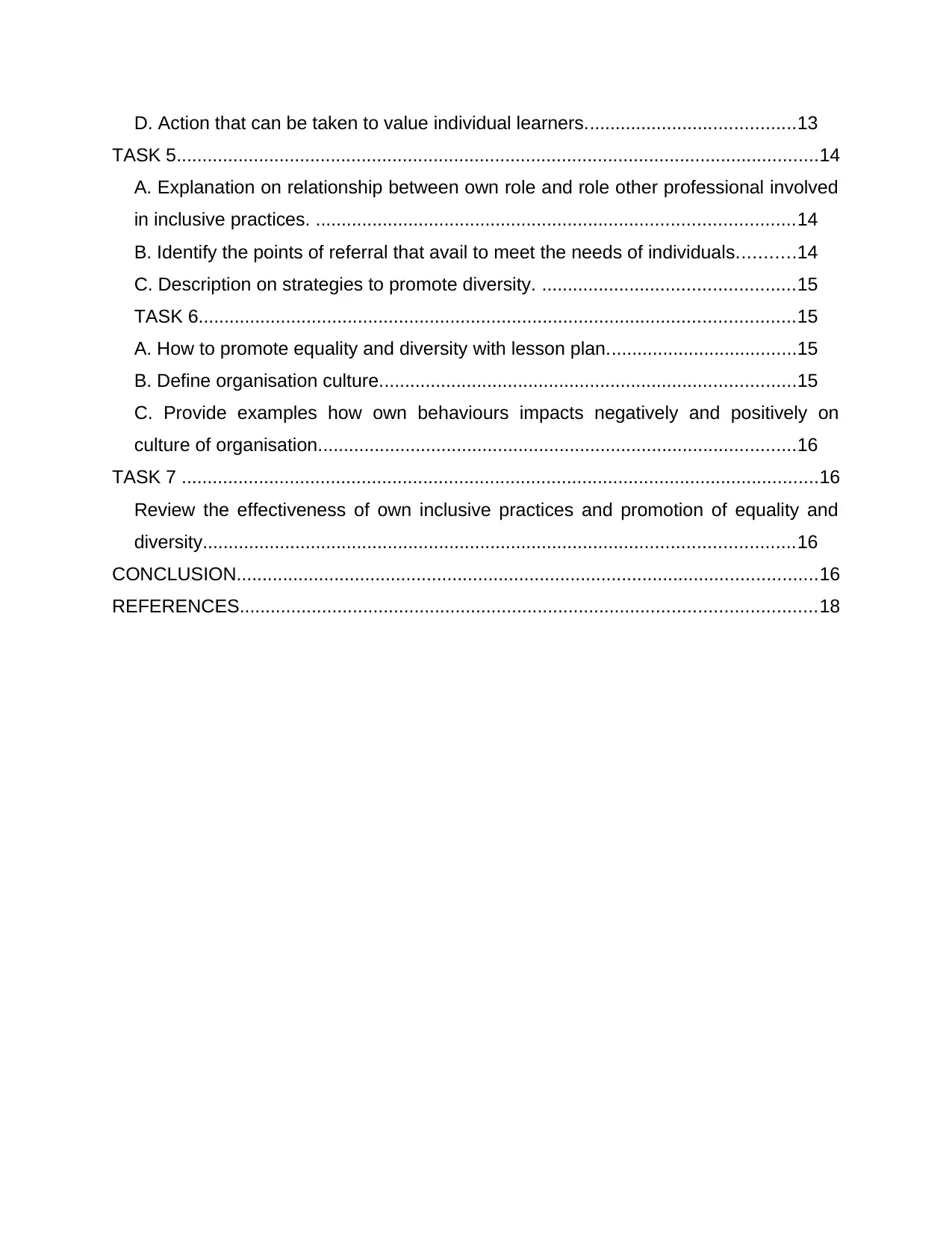
D. Action that can be taken to value individual learners.........................................13
TASK 5.............................................................................................................................14
A. Explanation on relationship between own role and role other professional involved
in inclusive practices. .............................................................................................14
B. Identify the points of referral that avail to meet the needs of individuals...........14
C. Description on strategies to promote diversity. .................................................15
TASK 6....................................................................................................................15
A. How to promote equality and diversity with lesson plan.....................................15
B. Define organisation culture.................................................................................15
C. Provide examples how own behaviours impacts negatively and positively on
culture of organisation.............................................................................................16
TASK 7 ............................................................................................................................16
Review the effectiveness of own inclusive practices and promotion of equality and
diversity...................................................................................................................16
CONCLUSION.................................................................................................................16
REFERENCES................................................................................................................18
TASK 5.............................................................................................................................14
A. Explanation on relationship between own role and role other professional involved
in inclusive practices. .............................................................................................14
B. Identify the points of referral that avail to meet the needs of individuals...........14
C. Description on strategies to promote diversity. .................................................15
TASK 6....................................................................................................................15
A. How to promote equality and diversity with lesson plan.....................................15
B. Define organisation culture.................................................................................15
C. Provide examples how own behaviours impacts negatively and positively on
culture of organisation.............................................................................................16
TASK 7 ............................................................................................................................16
Review the effectiveness of own inclusive practices and promotion of equality and
diversity...................................................................................................................16
CONCLUSION.................................................................................................................16
REFERENCES................................................................................................................18
⊘ This is a preview!⊘
Do you want full access?
Subscribe today to unlock all pages.

Trusted by 1+ million students worldwide
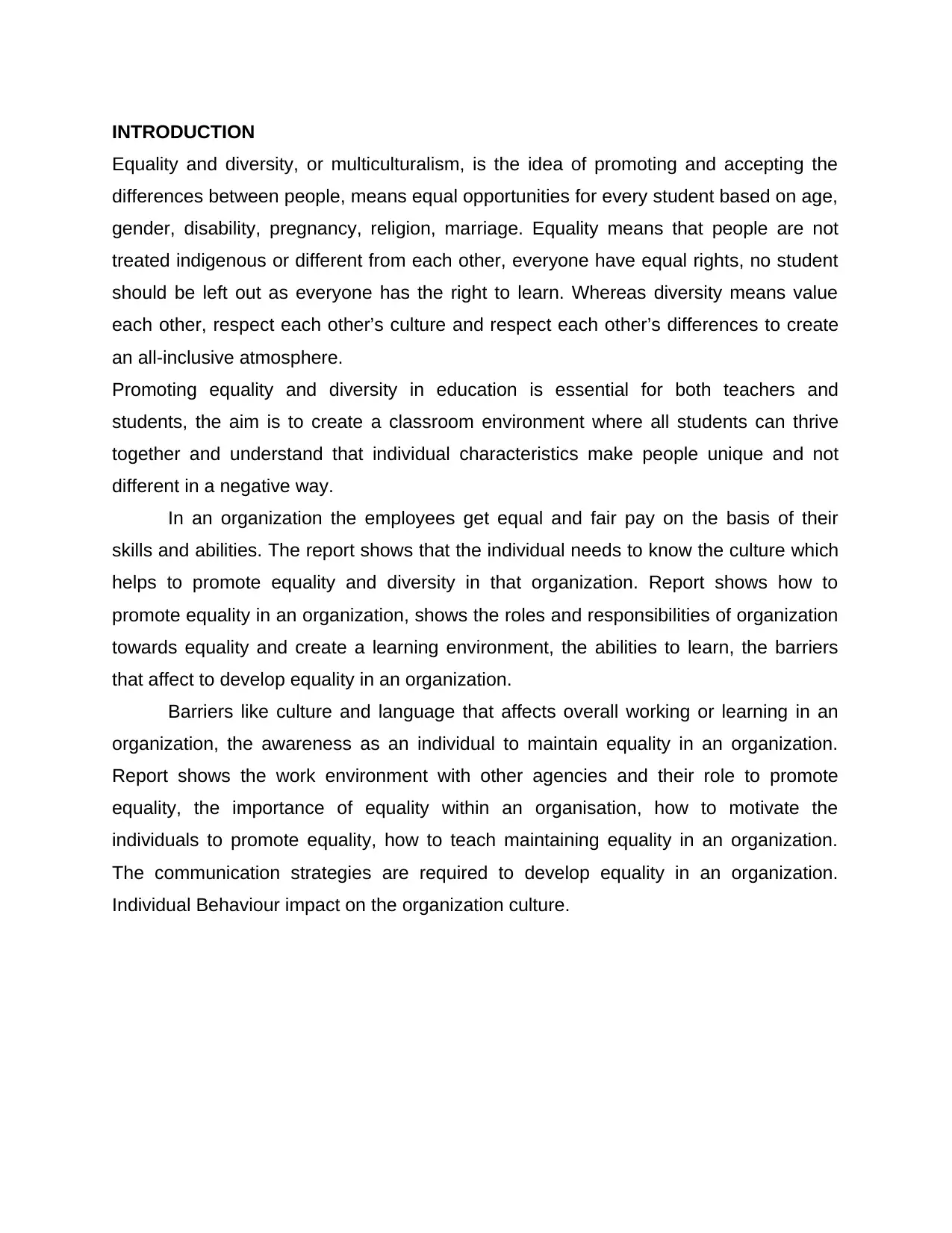
INTRODUCTION
Equality and diversity, or multiculturalism, is the idea of promoting and accepting the
differences between people, means equal opportunities for every student based on age,
gender, disability, pregnancy, religion, marriage. Equality means that people are not
treated indigenous or different from each other, everyone have equal rights, no student
should be left out as everyone has the right to learn. Whereas diversity means value
each other, respect each other’s culture and respect each other’s differences to create
an all-inclusive atmosphere.
Promoting equality and diversity in education is essential for both teachers and
students, the aim is to create a classroom environment where all students can thrive
together and understand that individual characteristics make people unique and not
different in a negative way.
In an organization the employees get equal and fair pay on the basis of their
skills and abilities. The report shows that the individual needs to know the culture which
helps to promote equality and diversity in that organization. Report shows how to
promote equality in an organization, shows the roles and responsibilities of organization
towards equality and create a learning environment, the abilities to learn, the barriers
that affect to develop equality in an organization.
Barriers like culture and language that affects overall working or learning in an
organization, the awareness as an individual to maintain equality in an organization.
Report shows the work environment with other agencies and their role to promote
equality, the importance of equality within an organisation, how to motivate the
individuals to promote equality, how to teach maintaining equality in an organization.
The communication strategies are required to develop equality in an organization.
Individual Behaviour impact on the organization culture.
Equality and diversity, or multiculturalism, is the idea of promoting and accepting the
differences between people, means equal opportunities for every student based on age,
gender, disability, pregnancy, religion, marriage. Equality means that people are not
treated indigenous or different from each other, everyone have equal rights, no student
should be left out as everyone has the right to learn. Whereas diversity means value
each other, respect each other’s culture and respect each other’s differences to create
an all-inclusive atmosphere.
Promoting equality and diversity in education is essential for both teachers and
students, the aim is to create a classroom environment where all students can thrive
together and understand that individual characteristics make people unique and not
different in a negative way.
In an organization the employees get equal and fair pay on the basis of their
skills and abilities. The report shows that the individual needs to know the culture which
helps to promote equality and diversity in that organization. Report shows how to
promote equality in an organization, shows the roles and responsibilities of organization
towards equality and create a learning environment, the abilities to learn, the barriers
that affect to develop equality in an organization.
Barriers like culture and language that affects overall working or learning in an
organization, the awareness as an individual to maintain equality in an organization.
Report shows the work environment with other agencies and their role to promote
equality, the importance of equality within an organisation, how to motivate the
individuals to promote equality, how to teach maintaining equality in an organization.
The communication strategies are required to develop equality in an organization.
Individual Behaviour impact on the organization culture.
Paraphrase This Document
Need a fresh take? Get an instant paraphrase of this document with our AI Paraphraser
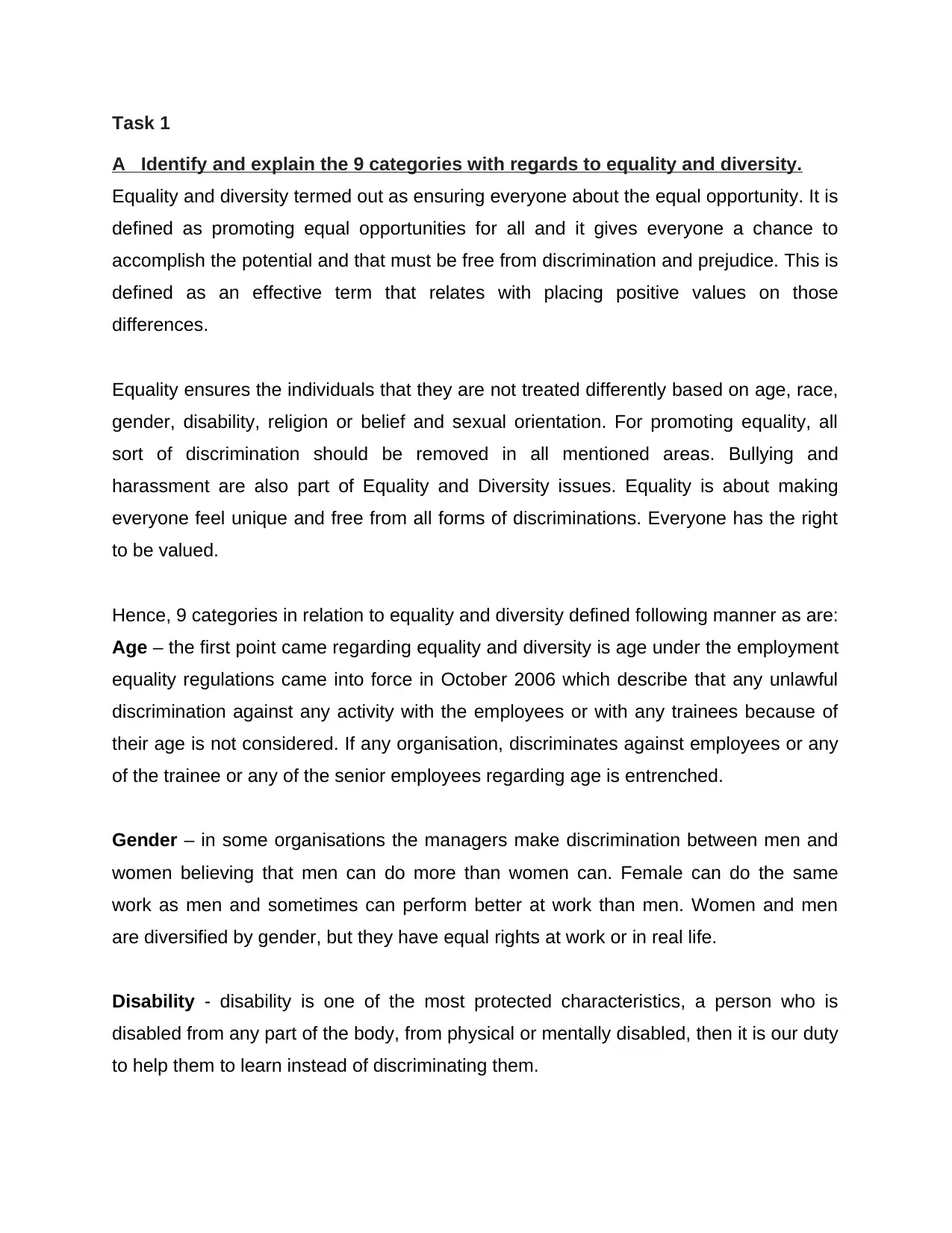
Task 1
A Identify and explain the 9 categories with regards to equality and diversity.
Equality and diversity termed out as ensuring everyone about the equal opportunity. It is
defined as promoting equal opportunities for all and it gives everyone a chance to
accomplish the potential and that must be free from discrimination and prejudice. This is
defined as an effective term that relates with placing positive values on those
differences.
Equality ensures the individuals that they are not treated differently based on age, race,
gender, disability, religion or belief and sexual orientation. For promoting equality, all
sort of discrimination should be removed in all mentioned areas. Bullying and
harassment are also part of Equality and Diversity issues. Equality is about making
everyone feel unique and free from all forms of discriminations. Everyone has the right
to be valued.
Hence, 9 categories in relation to equality and diversity defined following manner as are:
Age – the first point came regarding equality and diversity is age under the employment
equality regulations came into force in October 2006 which describe that any unlawful
discrimination against any activity with the employees or with any trainees because of
their age is not considered. If any organisation, discriminates against employees or any
of the trainee or any of the senior employees regarding age is entrenched.
Gender – in some organisations the managers make discrimination between men and
women believing that men can do more than women can. Female can do the same
work as men and sometimes can perform better at work than men. Women and men
are diversified by gender, but they have equal rights at work or in real life.
Disability - disability is one of the most protected characteristics, a person who is
disabled from any part of the body, from physical or mentally disabled, then it is our duty
to help them to learn instead of discriminating them.
A Identify and explain the 9 categories with regards to equality and diversity.
Equality and diversity termed out as ensuring everyone about the equal opportunity. It is
defined as promoting equal opportunities for all and it gives everyone a chance to
accomplish the potential and that must be free from discrimination and prejudice. This is
defined as an effective term that relates with placing positive values on those
differences.
Equality ensures the individuals that they are not treated differently based on age, race,
gender, disability, religion or belief and sexual orientation. For promoting equality, all
sort of discrimination should be removed in all mentioned areas. Bullying and
harassment are also part of Equality and Diversity issues. Equality is about making
everyone feel unique and free from all forms of discriminations. Everyone has the right
to be valued.
Hence, 9 categories in relation to equality and diversity defined following manner as are:
Age – the first point came regarding equality and diversity is age under the employment
equality regulations came into force in October 2006 which describe that any unlawful
discrimination against any activity with the employees or with any trainees because of
their age is not considered. If any organisation, discriminates against employees or any
of the trainee or any of the senior employees regarding age is entrenched.
Gender – in some organisations the managers make discrimination between men and
women believing that men can do more than women can. Female can do the same
work as men and sometimes can perform better at work than men. Women and men
are diversified by gender, but they have equal rights at work or in real life.
Disability - disability is one of the most protected characteristics, a person who is
disabled from any part of the body, from physical or mentally disabled, then it is our duty
to help them to learn instead of discriminating them.

Gender reassignment- is a personal or medical process through an individual’s gender
has being changed. It’s a process of transitioning from one gender to another. Anyone
who starts or has completed a process to change his or her gender is protected from
discrimination under the Equality Act (Employment, 2010).
Marriage and civil partnership- It’s about people who are legally married. The equality
Act makes it unlawful if these people are discriminated. For example, the same sex
couples who are civil partners must be treated like any other married couple.
Pregnancy and maternity- The Equality Act 2010 describes that where someone
threatens any woman on the base of pregnancy or in terms of maternity is a serious
matter and it’s against the law. Pregnancy is that period of time of being pregnant or
expecting a baby. Maternity is the period after child birth and it’s linked to maternity
leave. The law protects women during their pregnancy. The Act gives protection
against discrimination to women who are pregnant or maternity leave.
Race-This refers to the characteristics of race. Race refers to that group of people
defined by colour, nationality, ethic or national origin. In Equality Act 1976 says that it’s
being unlawful to “discriminate against anyone on ground of race, colour”. Every person
has the right to be treated fairly and be protected against racial discrimination.
Religion or belief- Person who has different trust of religion or any other beliefs Like if
a person who has some beliefs can be threatened by the classmates and this can affect
negatively their learning.
Sexual orientation- any abuse against any person that is attracted towards his or her
own sex or opposite sex or both sexes within an organization or class, they have the
right to be treated fairly. Any harassment on these persons is unlawful and it must be
considered as a crime. The law protects every individual against discrimination (Riach,
and Brewis, 2019)
has being changed. It’s a process of transitioning from one gender to another. Anyone
who starts or has completed a process to change his or her gender is protected from
discrimination under the Equality Act (Employment, 2010).
Marriage and civil partnership- It’s about people who are legally married. The equality
Act makes it unlawful if these people are discriminated. For example, the same sex
couples who are civil partners must be treated like any other married couple.
Pregnancy and maternity- The Equality Act 2010 describes that where someone
threatens any woman on the base of pregnancy or in terms of maternity is a serious
matter and it’s against the law. Pregnancy is that period of time of being pregnant or
expecting a baby. Maternity is the period after child birth and it’s linked to maternity
leave. The law protects women during their pregnancy. The Act gives protection
against discrimination to women who are pregnant or maternity leave.
Race-This refers to the characteristics of race. Race refers to that group of people
defined by colour, nationality, ethic or national origin. In Equality Act 1976 says that it’s
being unlawful to “discriminate against anyone on ground of race, colour”. Every person
has the right to be treated fairly and be protected against racial discrimination.
Religion or belief- Person who has different trust of religion or any other beliefs Like if
a person who has some beliefs can be threatened by the classmates and this can affect
negatively their learning.
Sexual orientation- any abuse against any person that is attracted towards his or her
own sex or opposite sex or both sexes within an organization or class, they have the
right to be treated fairly. Any harassment on these persons is unlawful and it must be
considered as a crime. The law protects every individual against discrimination (Riach,
and Brewis, 2019)
⊘ This is a preview!⊘
Do you want full access?
Subscribe today to unlock all pages.

Trusted by 1+ million students worldwide
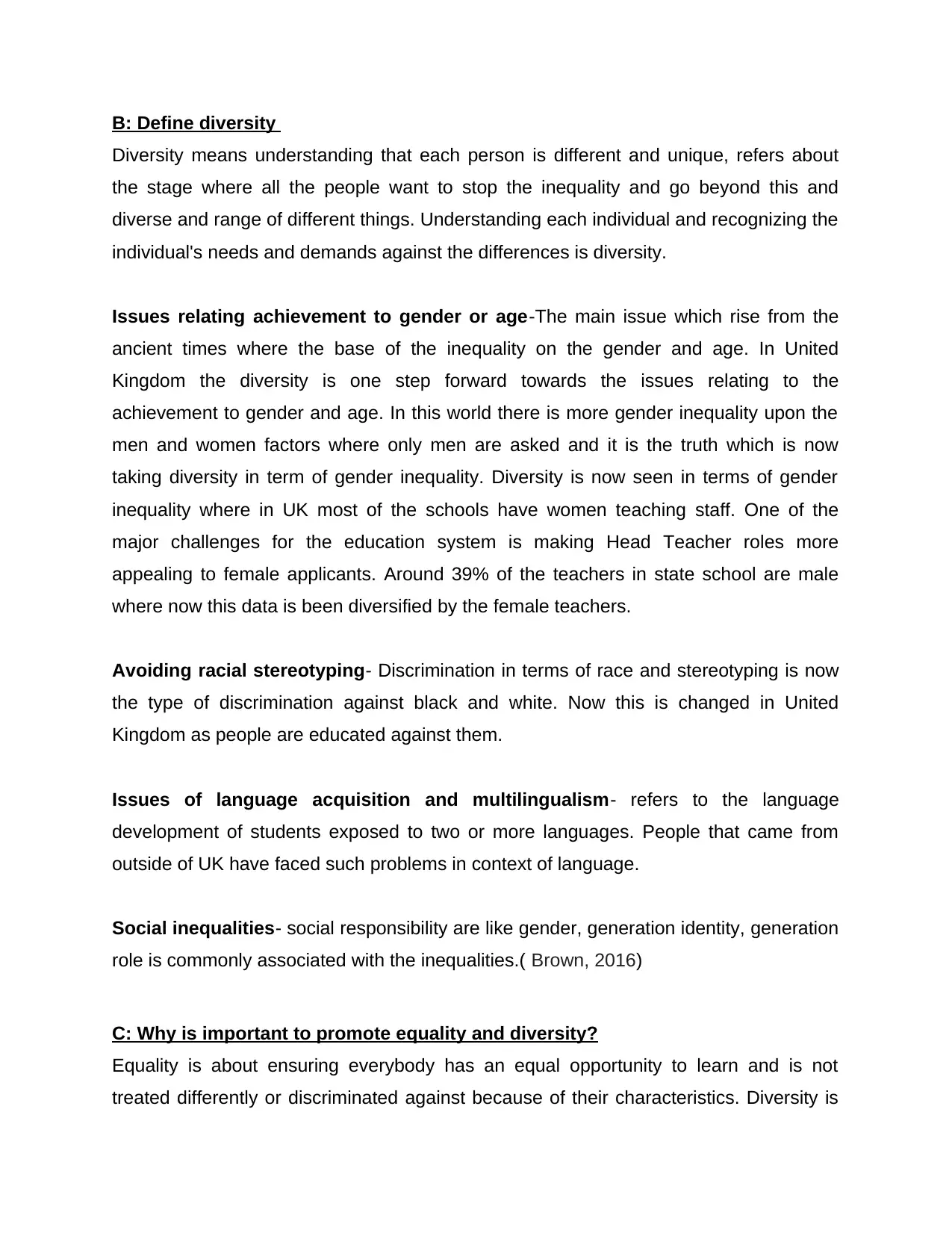
B: Define diversity
Diversity means understanding that each person is different and unique, refers about
the stage where all the people want to stop the inequality and go beyond this and
diverse and range of different things. Understanding each individual and recognizing the
individual's needs and demands against the differences is diversity.
Issues relating achievement to gender or age-The main issue which rise from the
ancient times where the base of the inequality on the gender and age. In United
Kingdom the diversity is one step forward towards the issues relating to the
achievement to gender and age. In this world there is more gender inequality upon the
men and women factors where only men are asked and it is the truth which is now
taking diversity in term of gender inequality. Diversity is now seen in terms of gender
inequality where in UK most of the schools have women teaching staff. One of the
major challenges for the education system is making Head Teacher roles more
appealing to female applicants. Around 39% of the teachers in state school are male
where now this data is been diversified by the female teachers.
Avoiding racial stereotyping- Discrimination in terms of race and stereotyping is now
the type of discrimination against black and white. Now this is changed in United
Kingdom as people are educated against them.
Issues of language acquisition and multilingualism- refers to the language
development of students exposed to two or more languages. People that came from
outside of UK have faced such problems in context of language.
Social inequalities- social responsibility are like gender, generation identity, generation
role is commonly associated with the inequalities.( Brown, 2016)
C: Why is important to promote equality and diversity?
Equality is about ensuring everybody has an equal opportunity to learn and is not
treated differently or discriminated against because of their characteristics. Diversity is
Diversity means understanding that each person is different and unique, refers about
the stage where all the people want to stop the inequality and go beyond this and
diverse and range of different things. Understanding each individual and recognizing the
individual's needs and demands against the differences is diversity.
Issues relating achievement to gender or age-The main issue which rise from the
ancient times where the base of the inequality on the gender and age. In United
Kingdom the diversity is one step forward towards the issues relating to the
achievement to gender and age. In this world there is more gender inequality upon the
men and women factors where only men are asked and it is the truth which is now
taking diversity in term of gender inequality. Diversity is now seen in terms of gender
inequality where in UK most of the schools have women teaching staff. One of the
major challenges for the education system is making Head Teacher roles more
appealing to female applicants. Around 39% of the teachers in state school are male
where now this data is been diversified by the female teachers.
Avoiding racial stereotyping- Discrimination in terms of race and stereotyping is now
the type of discrimination against black and white. Now this is changed in United
Kingdom as people are educated against them.
Issues of language acquisition and multilingualism- refers to the language
development of students exposed to two or more languages. People that came from
outside of UK have faced such problems in context of language.
Social inequalities- social responsibility are like gender, generation identity, generation
role is commonly associated with the inequalities.( Brown, 2016)
C: Why is important to promote equality and diversity?
Equality is about ensuring everybody has an equal opportunity to learn and is not
treated differently or discriminated against because of their characteristics. Diversity is
Paraphrase This Document
Need a fresh take? Get an instant paraphrase of this document with our AI Paraphraser
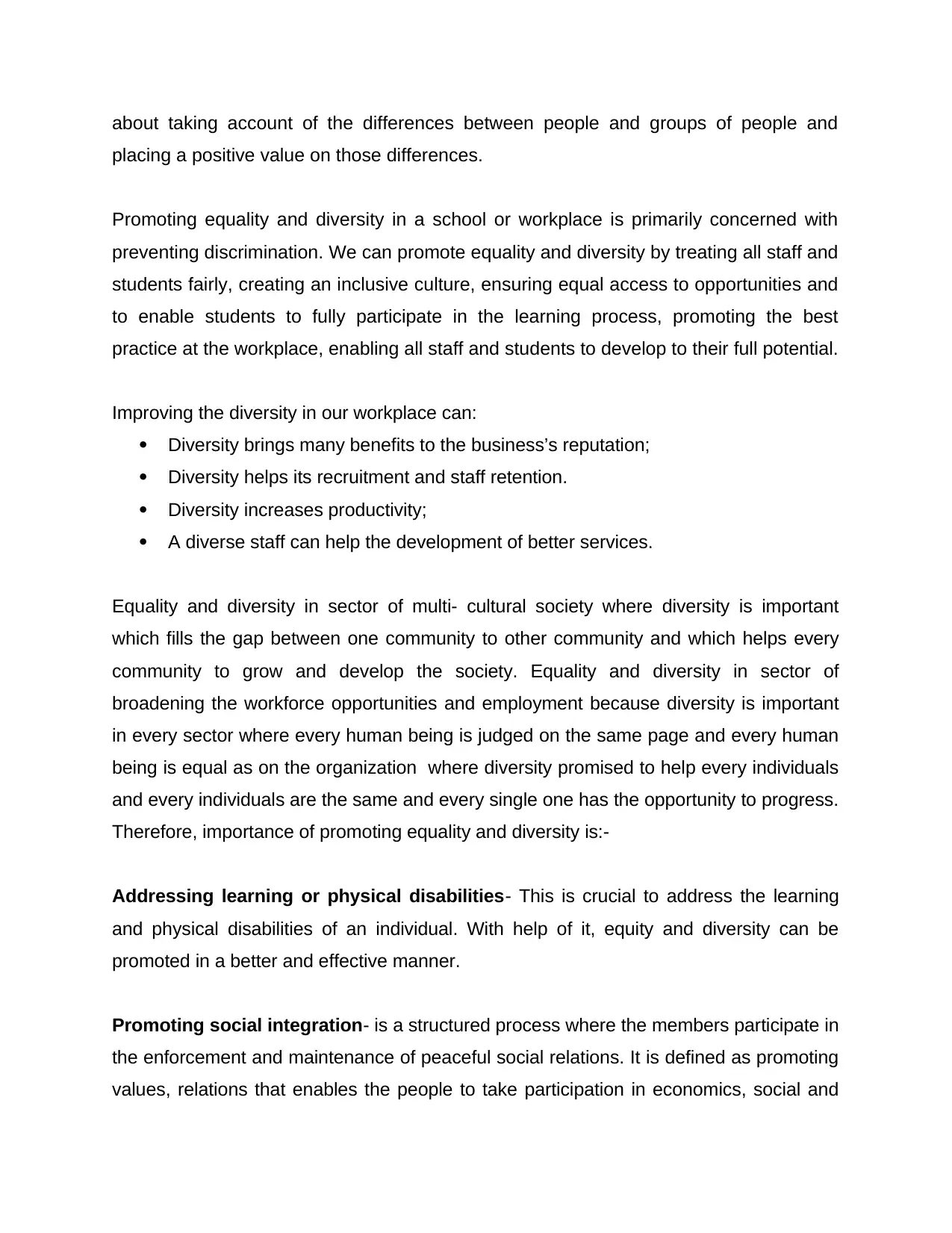
about taking account of the differences between people and groups of people and
placing a positive value on those differences.
Promoting equality and diversity in a school or workplace is primarily concerned with
preventing discrimination. We can promote equality and diversity by treating all staff and
students fairly, creating an inclusive culture, ensuring equal access to opportunities and
to enable students to fully participate in the learning process, promoting the best
practice at the workplace, enabling all staff and students to develop to their full potential.
Improving the diversity in our workplace can:
Diversity brings many benefits to the business’s reputation;
Diversity helps its recruitment and staff retention.
Diversity increases productivity;
A diverse staff can help the development of better services.
Equality and diversity in sector of multi- cultural society where diversity is important
which fills the gap between one community to other community and which helps every
community to grow and develop the society. Equality and diversity in sector of
broadening the workforce opportunities and employment because diversity is important
in every sector where every human being is judged on the same page and every human
being is equal as on the organization where diversity promised to help every individuals
and every individuals are the same and every single one has the opportunity to progress.
Therefore, importance of promoting equality and diversity is:-
Addressing learning or physical disabilities- This is crucial to address the learning
and physical disabilities of an individual. With help of it, equity and diversity can be
promoted in a better and effective manner.
Promoting social integration- is a structured process where the members participate in
the enforcement and maintenance of peaceful social relations. It is defined as promoting
values, relations that enables the people to take participation in economics, social and
placing a positive value on those differences.
Promoting equality and diversity in a school or workplace is primarily concerned with
preventing discrimination. We can promote equality and diversity by treating all staff and
students fairly, creating an inclusive culture, ensuring equal access to opportunities and
to enable students to fully participate in the learning process, promoting the best
practice at the workplace, enabling all staff and students to develop to their full potential.
Improving the diversity in our workplace can:
Diversity brings many benefits to the business’s reputation;
Diversity helps its recruitment and staff retention.
Diversity increases productivity;
A diverse staff can help the development of better services.
Equality and diversity in sector of multi- cultural society where diversity is important
which fills the gap between one community to other community and which helps every
community to grow and develop the society. Equality and diversity in sector of
broadening the workforce opportunities and employment because diversity is important
in every sector where every human being is judged on the same page and every human
being is equal as on the organization where diversity promised to help every individuals
and every individuals are the same and every single one has the opportunity to progress.
Therefore, importance of promoting equality and diversity is:-
Addressing learning or physical disabilities- This is crucial to address the learning
and physical disabilities of an individual. With help of it, equity and diversity can be
promoted in a better and effective manner.
Promoting social integration- is a structured process where the members participate in
the enforcement and maintenance of peaceful social relations. It is defined as promoting
values, relations that enables the people to take participation in economics, social and
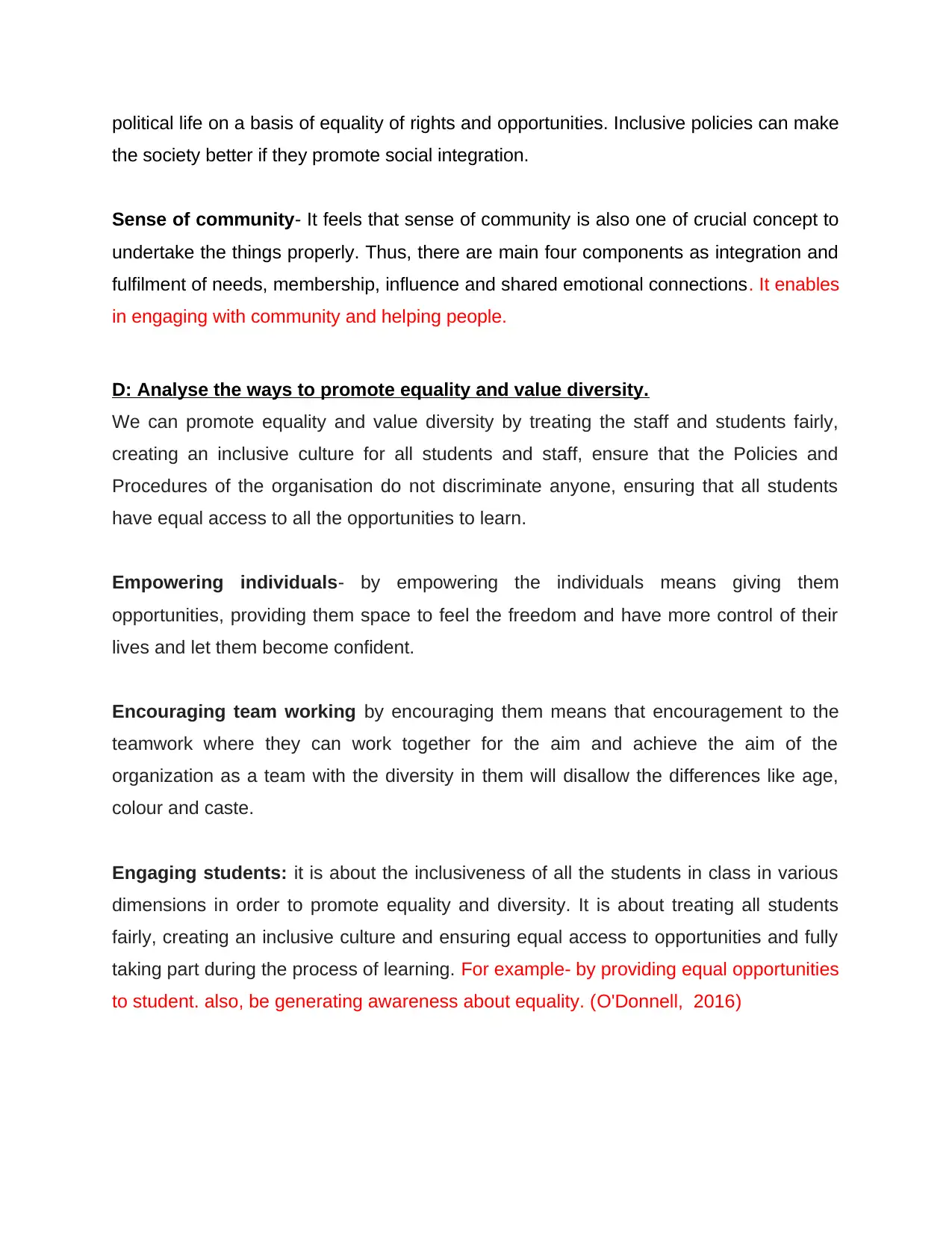
political life on a basis of equality of rights and opportunities. Inclusive policies can make
the society better if they promote social integration.
Sense of community- It feels that sense of community is also one of crucial concept to
undertake the things properly. Thus, there are main four components as integration and
fulfilment of needs, membership, influence and shared emotional connections. It enables
in engaging with community and helping people.
D: Analyse the ways to promote equality and value diversity.
We can promote equality and value diversity by treating the staff and students fairly,
creating an inclusive culture for all students and staff, ensure that the Policies and
Procedures of the organisation do not discriminate anyone, ensuring that all students
have equal access to all the opportunities to learn.
Empowering individuals- by empowering the individuals means giving them
opportunities, providing them space to feel the freedom and have more control of their
lives and let them become confident.
Encouraging team working by encouraging them means that encouragement to the
teamwork where they can work together for the aim and achieve the aim of the
organization as a team with the diversity in them will disallow the differences like age,
colour and caste.
Engaging students: it is about the inclusiveness of all the students in class in various
dimensions in order to promote equality and diversity. It is about treating all students
fairly, creating an inclusive culture and ensuring equal access to opportunities and fully
taking part during the process of learning. For example- by providing equal opportunities
to student. also, be generating awareness about equality. (O'Donnell, 2016)
the society better if they promote social integration.
Sense of community- It feels that sense of community is also one of crucial concept to
undertake the things properly. Thus, there are main four components as integration and
fulfilment of needs, membership, influence and shared emotional connections. It enables
in engaging with community and helping people.
D: Analyse the ways to promote equality and value diversity.
We can promote equality and value diversity by treating the staff and students fairly,
creating an inclusive culture for all students and staff, ensure that the Policies and
Procedures of the organisation do not discriminate anyone, ensuring that all students
have equal access to all the opportunities to learn.
Empowering individuals- by empowering the individuals means giving them
opportunities, providing them space to feel the freedom and have more control of their
lives and let them become confident.
Encouraging team working by encouraging them means that encouragement to the
teamwork where they can work together for the aim and achieve the aim of the
organization as a team with the diversity in them will disallow the differences like age,
colour and caste.
Engaging students: it is about the inclusiveness of all the students in class in various
dimensions in order to promote equality and diversity. It is about treating all students
fairly, creating an inclusive culture and ensuring equal access to opportunities and fully
taking part during the process of learning. For example- by providing equal opportunities
to student. also, be generating awareness about equality. (O'Donnell, 2016)
⊘ This is a preview!⊘
Do you want full access?
Subscribe today to unlock all pages.

Trusted by 1+ million students worldwide
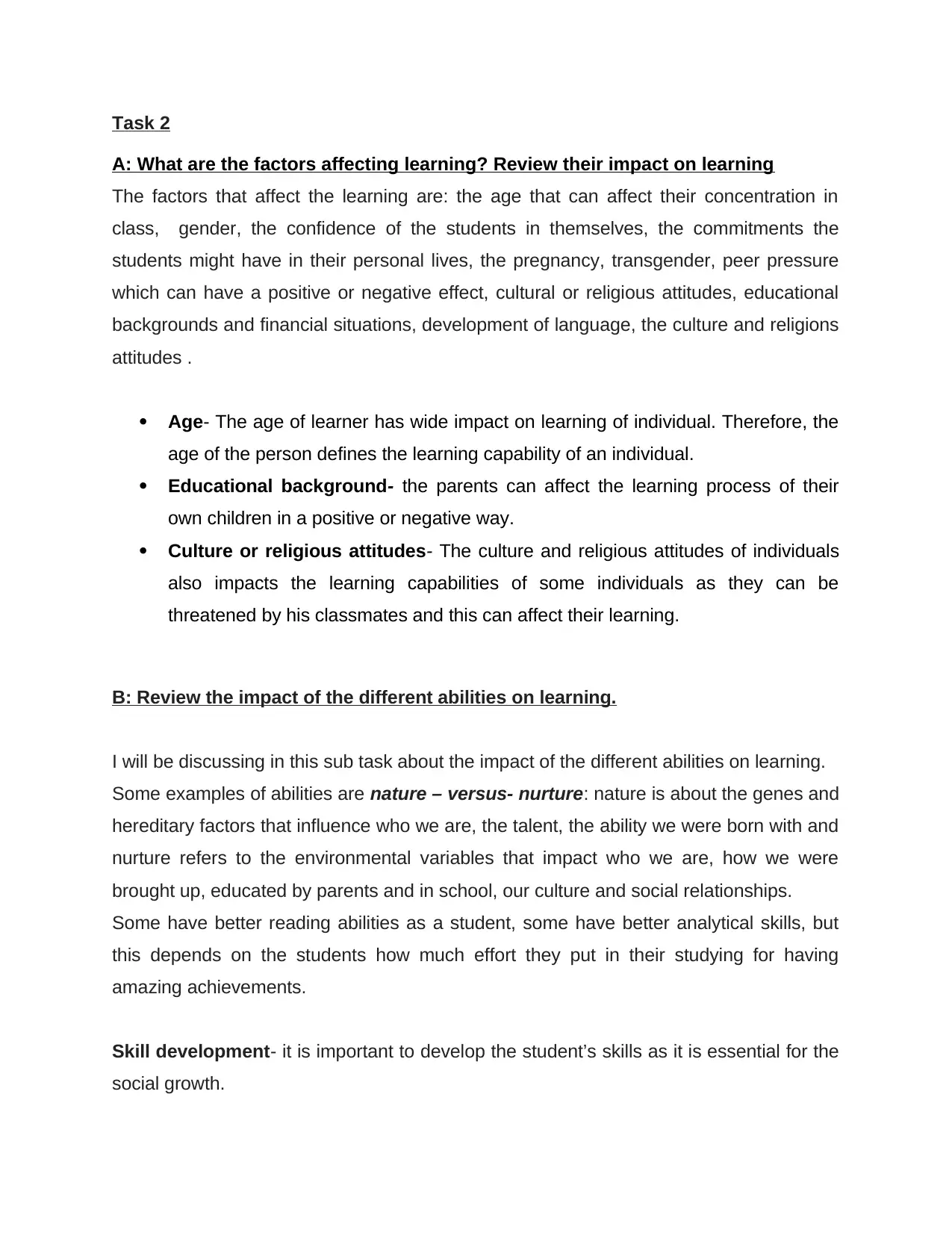
Task 2
A: What are the factors affecting learning? Review their impact on learning
The factors that affect the learning are: the age that can affect their concentration in
class, gender, the confidence of the students in themselves, the commitments the
students might have in their personal lives, the pregnancy, transgender, peer pressure
which can have a positive or negative effect, cultural or religious attitudes, educational
backgrounds and financial situations, development of language, the culture and religions
attitudes .
Age- The age of learner has wide impact on learning of individual. Therefore, the
age of the person defines the learning capability of an individual.
Educational background- the parents can affect the learning process of their
own children in a positive or negative way.
Culture or religious attitudes- The culture and religious attitudes of individuals
also impacts the learning capabilities of some individuals as they can be
threatened by his classmates and this can affect their learning.
B: Review the impact of the different abilities on learning.
I will be discussing in this sub task about the impact of the different abilities on learning.
Some examples of abilities are nature – versus- nurture: nature is about the genes and
hereditary factors that influence who we are, the talent, the ability we were born with and
nurture refers to the environmental variables that impact who we are, how we were
brought up, educated by parents and in school, our culture and social relationships.
Some have better reading abilities as a student, some have better analytical skills, but
this depends on the students how much effort they put in their studying for having
amazing achievements.
Skill development- it is important to develop the student’s skills as it is essential for the
social growth.
A: What are the factors affecting learning? Review their impact on learning
The factors that affect the learning are: the age that can affect their concentration in
class, gender, the confidence of the students in themselves, the commitments the
students might have in their personal lives, the pregnancy, transgender, peer pressure
which can have a positive or negative effect, cultural or religious attitudes, educational
backgrounds and financial situations, development of language, the culture and religions
attitudes .
Age- The age of learner has wide impact on learning of individual. Therefore, the
age of the person defines the learning capability of an individual.
Educational background- the parents can affect the learning process of their
own children in a positive or negative way.
Culture or religious attitudes- The culture and religious attitudes of individuals
also impacts the learning capabilities of some individuals as they can be
threatened by his classmates and this can affect their learning.
B: Review the impact of the different abilities on learning.
I will be discussing in this sub task about the impact of the different abilities on learning.
Some examples of abilities are nature – versus- nurture: nature is about the genes and
hereditary factors that influence who we are, the talent, the ability we were born with and
nurture refers to the environmental variables that impact who we are, how we were
brought up, educated by parents and in school, our culture and social relationships.
Some have better reading abilities as a student, some have better analytical skills, but
this depends on the students how much effort they put in their studying for having
amazing achievements.
Skill development- it is important to develop the student’s skills as it is essential for the
social growth.
Paraphrase This Document
Need a fresh take? Get an instant paraphrase of this document with our AI Paraphraser
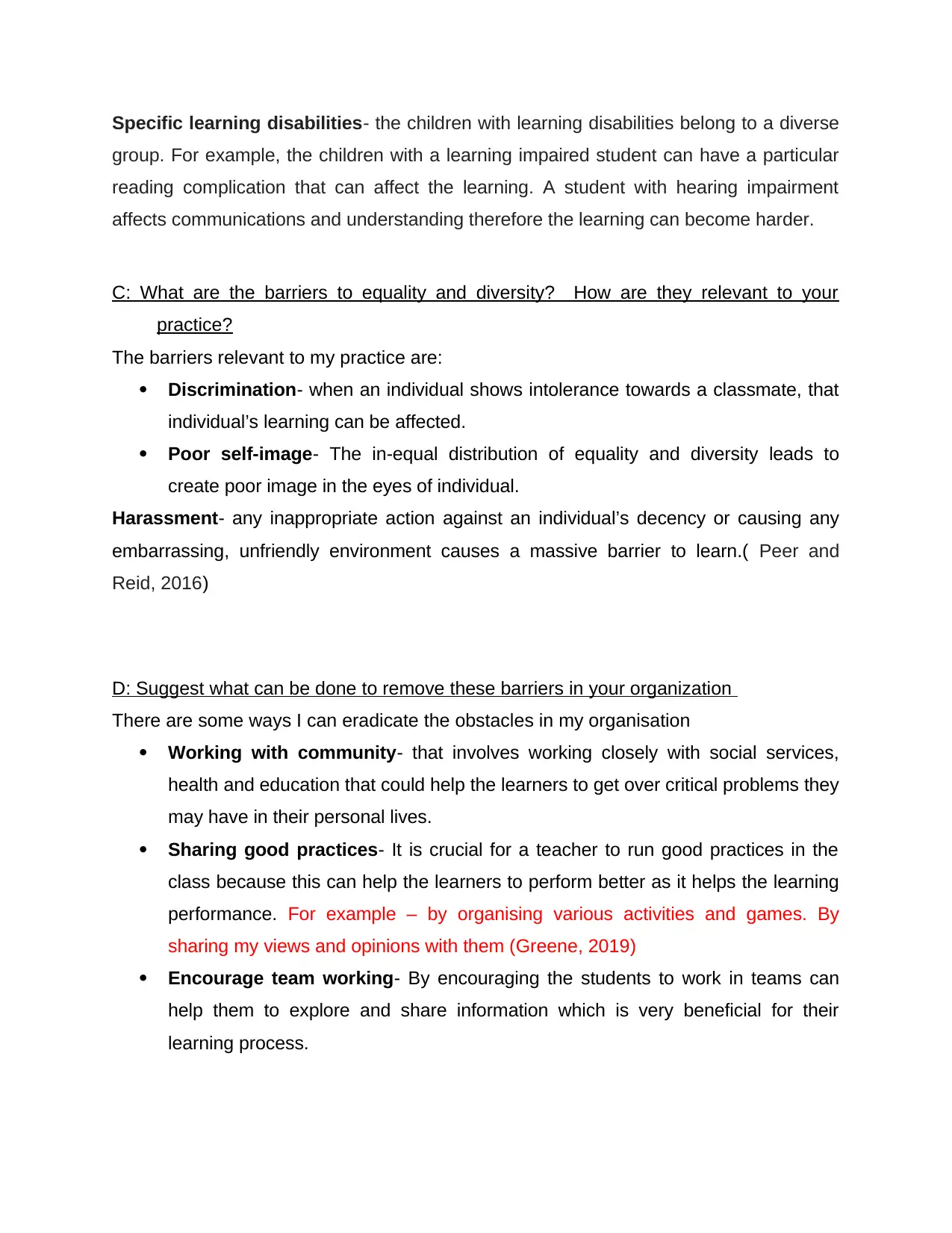
Specific learning disabilities- the children with learning disabilities belong to a diverse
group. For example, the children with a learning impaired student can have a particular
reading complication that can affect the learning. A student with hearing impairment
affects communications and understanding therefore the learning can become harder.
C: What are the barriers to equality and diversity? How are they relevant to your
practice?
The barriers relevant to my practice are:
Discrimination- when an individual shows intolerance towards a classmate, that
individual’s learning can be affected.
Poor self-image- The in-equal distribution of equality and diversity leads to
create poor image in the eyes of individual.
Harassment- any inappropriate action against an individual’s decency or causing any
embarrassing, unfriendly environment causes a massive barrier to learn.( Peer and
Reid, 2016)
D: Suggest what can be done to remove these barriers in your organization
There are some ways I can eradicate the obstacles in my organisation
Working with community- that involves working closely with social services,
health and education that could help the learners to get over critical problems they
may have in their personal lives.
Sharing good practices- It is crucial for a teacher to run good practices in the
class because this can help the learners to perform better as it helps the learning
performance. For example – by organising various activities and games. By
sharing my views and opinions with them (Greene, 2019)
Encourage team working- By encouraging the students to work in teams can
help them to explore and share information which is very beneficial for their
learning process.
group. For example, the children with a learning impaired student can have a particular
reading complication that can affect the learning. A student with hearing impairment
affects communications and understanding therefore the learning can become harder.
C: What are the barriers to equality and diversity? How are they relevant to your
practice?
The barriers relevant to my practice are:
Discrimination- when an individual shows intolerance towards a classmate, that
individual’s learning can be affected.
Poor self-image- The in-equal distribution of equality and diversity leads to
create poor image in the eyes of individual.
Harassment- any inappropriate action against an individual’s decency or causing any
embarrassing, unfriendly environment causes a massive barrier to learn.( Peer and
Reid, 2016)
D: Suggest what can be done to remove these barriers in your organization
There are some ways I can eradicate the obstacles in my organisation
Working with community- that involves working closely with social services,
health and education that could help the learners to get over critical problems they
may have in their personal lives.
Sharing good practices- It is crucial for a teacher to run good practices in the
class because this can help the learners to perform better as it helps the learning
performance. For example – by organising various activities and games. By
sharing my views and opinions with them (Greene, 2019)
Encourage team working- By encouraging the students to work in teams can
help them to explore and share information which is very beneficial for their
learning process.
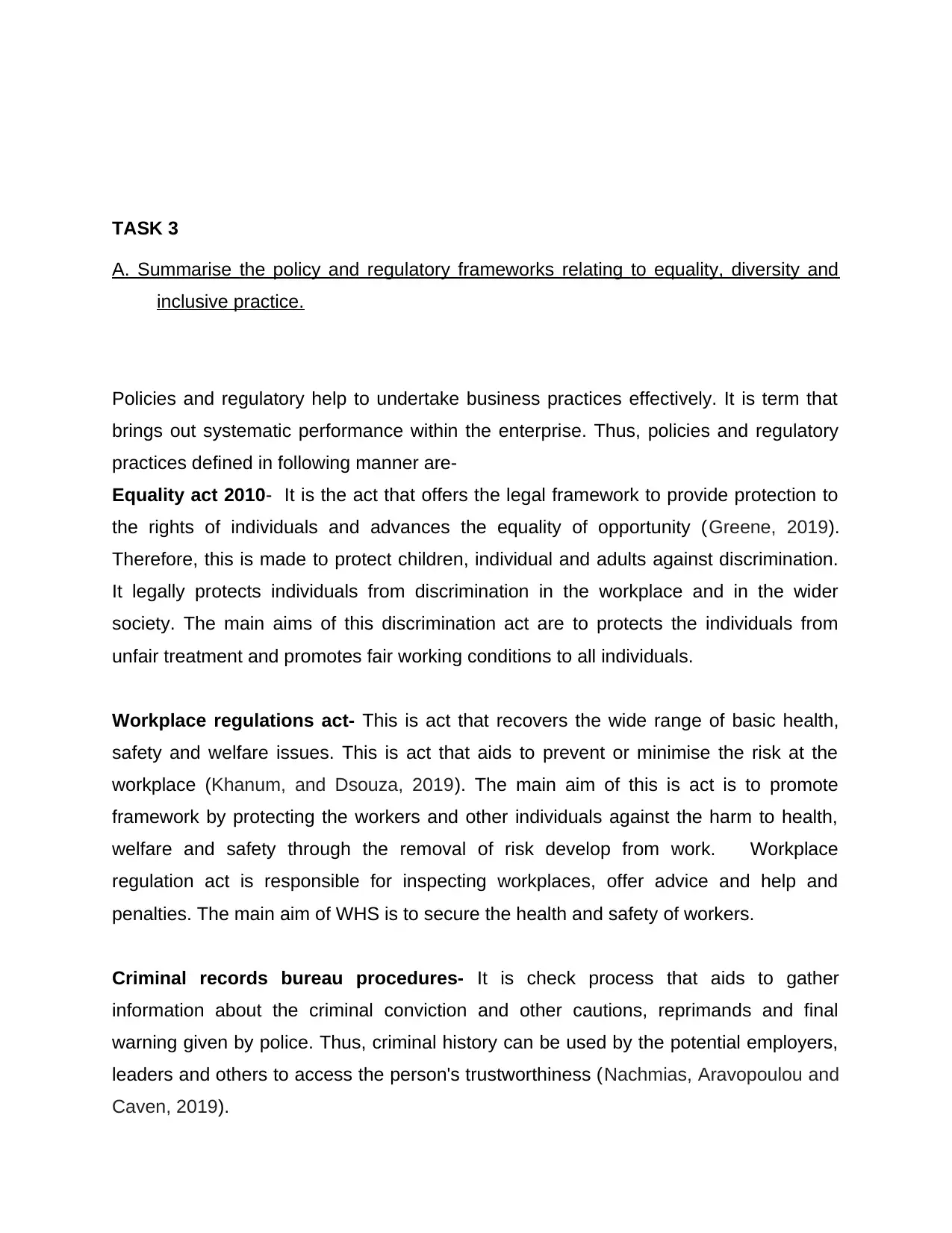
TASK 3
A. Summarise the policy and regulatory frameworks relating to equality, diversity and
inclusive practice.
Policies and regulatory help to undertake business practices effectively. It is term that
brings out systematic performance within the enterprise. Thus, policies and regulatory
practices defined in following manner are-
Equality act 2010- It is the act that offers the legal framework to provide protection to
the rights of individuals and advances the equality of opportunity (Greene, 2019).
Therefore, this is made to protect children, individual and adults against discrimination.
It legally protects individuals from discrimination in the workplace and in the wider
society. The main aims of this discrimination act are to protects the individuals from
unfair treatment and promotes fair working conditions to all individuals.
Workplace regulations act- This is act that recovers the wide range of basic health,
safety and welfare issues. This is act that aids to prevent or minimise the risk at the
workplace (Khanum, and Dsouza, 2019). The main aim of this is act is to promote
framework by protecting the workers and other individuals against the harm to health,
welfare and safety through the removal of risk develop from work. Workplace
regulation act is responsible for inspecting workplaces, offer advice and help and
penalties. The main aim of WHS is to secure the health and safety of workers.
Criminal records bureau procedures- It is check process that aids to gather
information about the criminal conviction and other cautions, reprimands and final
warning given by police. Thus, criminal history can be used by the potential employers,
leaders and others to access the person's trustworthiness (Nachmias, Aravopoulou and
Caven, 2019).
A. Summarise the policy and regulatory frameworks relating to equality, diversity and
inclusive practice.
Policies and regulatory help to undertake business practices effectively. It is term that
brings out systematic performance within the enterprise. Thus, policies and regulatory
practices defined in following manner are-
Equality act 2010- It is the act that offers the legal framework to provide protection to
the rights of individuals and advances the equality of opportunity (Greene, 2019).
Therefore, this is made to protect children, individual and adults against discrimination.
It legally protects individuals from discrimination in the workplace and in the wider
society. The main aims of this discrimination act are to protects the individuals from
unfair treatment and promotes fair working conditions to all individuals.
Workplace regulations act- This is act that recovers the wide range of basic health,
safety and welfare issues. This is act that aids to prevent or minimise the risk at the
workplace (Khanum, and Dsouza, 2019). The main aim of this is act is to promote
framework by protecting the workers and other individuals against the harm to health,
welfare and safety through the removal of risk develop from work. Workplace
regulation act is responsible for inspecting workplaces, offer advice and help and
penalties. The main aim of WHS is to secure the health and safety of workers.
Criminal records bureau procedures- It is check process that aids to gather
information about the criminal conviction and other cautions, reprimands and final
warning given by police. Thus, criminal history can be used by the potential employers,
leaders and others to access the person's trustworthiness (Nachmias, Aravopoulou and
Caven, 2019).
⊘ This is a preview!⊘
Do you want full access?
Subscribe today to unlock all pages.

Trusted by 1+ million students worldwide
1 out of 26
Related Documents
Your All-in-One AI-Powered Toolkit for Academic Success.
+13062052269
info@desklib.com
Available 24*7 on WhatsApp / Email
![[object Object]](/_next/static/media/star-bottom.7253800d.svg)
Unlock your academic potential
Copyright © 2020–2025 A2Z Services. All Rights Reserved. Developed and managed by ZUCOL.





